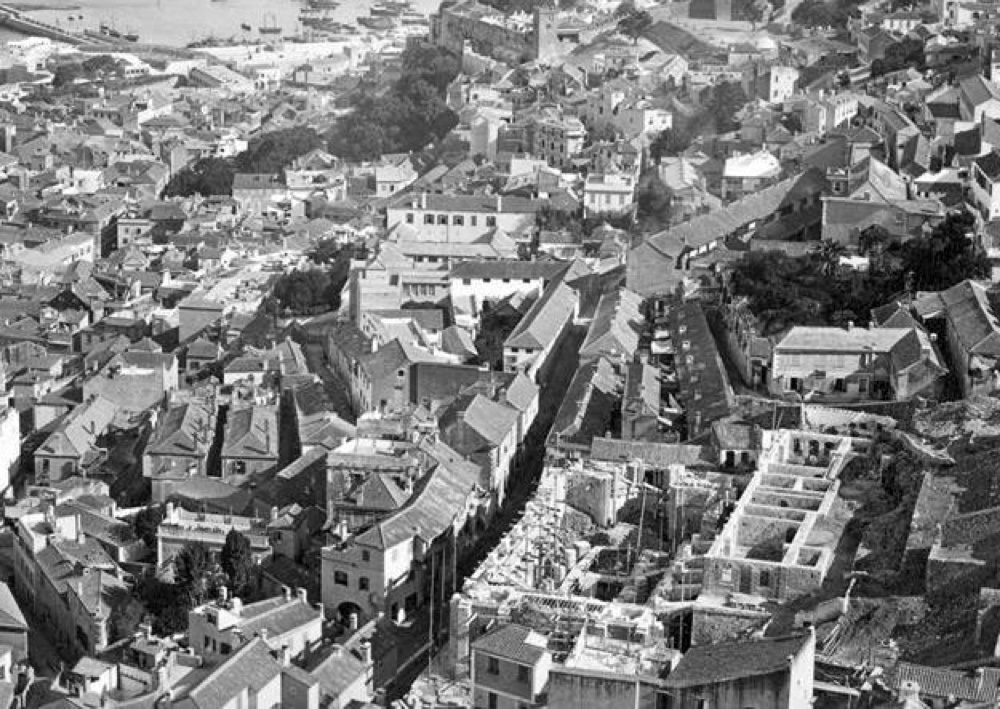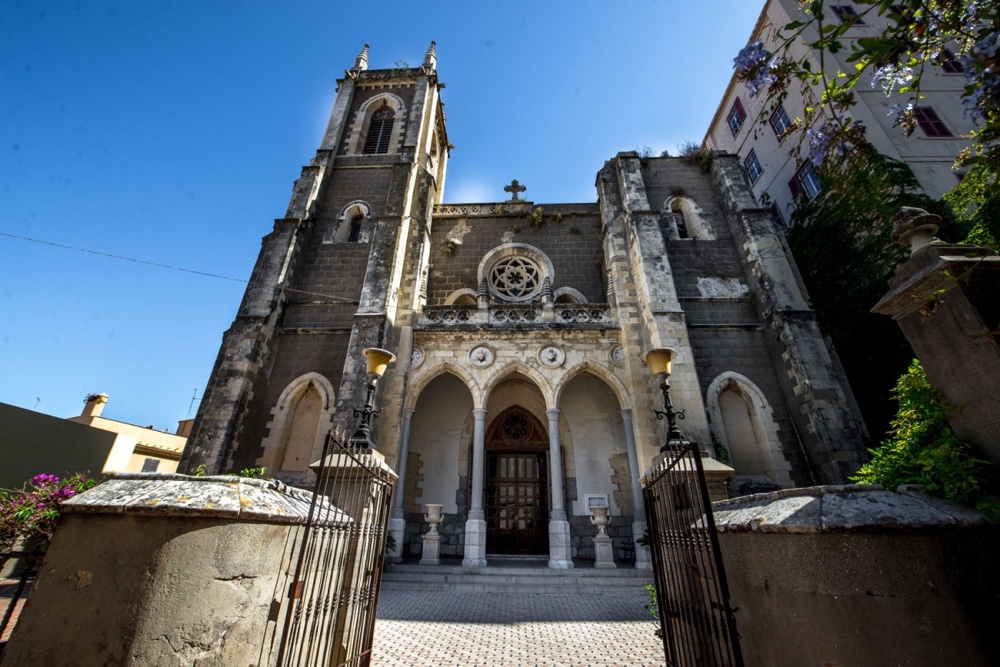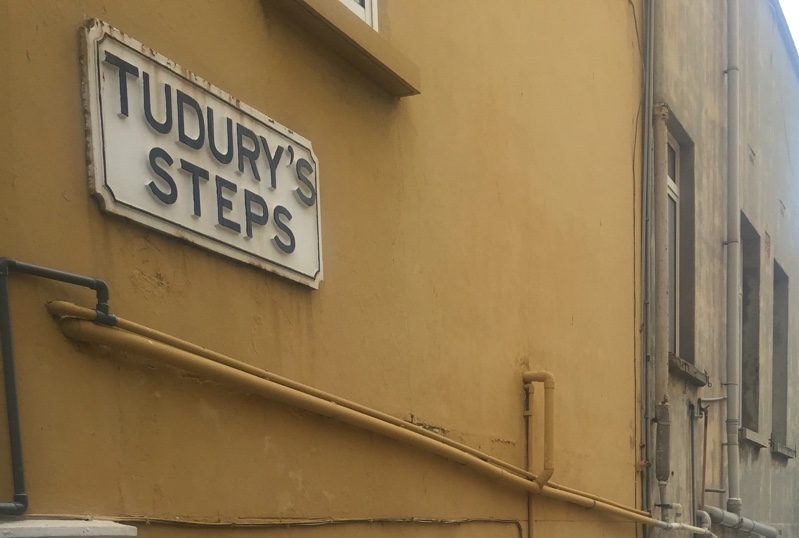When I finished writing the book The “Minorkeens” of Gibraltar (PAMSA, 2018), I was quite certain of what I wanted to go on the cover: it should show an element of present-day Gibraltar connecting us back to the Menorcan community that settled in Gibraltar between the mid-18th Century and early 19th Century. There was no doubt, then, that the name-plaque for Tudury’s Steps, fixed to a wall painted in yellow located in the Upper Town area of the city, was what I was looking for. I knew almost nothing about the Tudurí immortalised in the Gibraltarian street name, but it was clear to me that such a family name could only come from Menorca.
Although when I was carrying out my research on the Menorcans on the Rock individuals with this surname appeared from time to time, it was not until the publication of the book A Rocky Labyrinth (2023) on the history of the streets of Gibraltar, by local researcher Manolo Galliano, that I looked a little more closely into this. According to the entry in his book on ‘Tudury’s Steps’:
‘This is a small cul-de-sac in the southern section of Prince Edward’s Road and is named thus because the property therein, House No 17 in the 1814 Register of Inhabitants, was owned by a tailor, Anthony Tudury. Another later well-known member of this family was Temistio Tudury, the architect, who designed the Gothic style Church of the Sacred Heart in 1874 and the copper cupola of the Cathedral of St. Mary the Crowned in the early 1930s.’
In addition to the tailor who already lived in the area in 1814, Galliano points out that within the Tuduri family there had also been a quite prominent architect, at least in terms of Gibraltar given its size, bearing in mind that he was in charge of designing the project for the Church of the Sacred Heart of Jesus, the second most important of the Catholic community in the city after the Cathedral of Saint Mary the Crowned. It was enough reason, in my opinion, to try to follow the trail of one figure, that of Themistius, baptised with a name with Greco-Latin roots recalling the ancient philosopher.

The Church of the Sacred Heart of Jesus
The exponential increase in population that Gibraltar experienced throughout the 19th Century led to growing demographic pressure in the upper part of the city, as well as to difficulties in the Cathedral to accommodate the large Catholic community, who were a majority in Gibraltar. All this prompted John Baptist Scandella, Vicar Apostolic of Gibraltar (1857-1880), to push for the construction of a new church in this area. No sooner said than done; in 1872 the Colonial Government offered a plot of land on Castle Road and funds were quickly sought to finance the future church.
A young local architect, Temistio Tudury Sáenz, who lived round the corner from where the church was to be located, enthusiastically joined the project. He was so eager to become involved that it seems he offered his services for free. Shortly after receiving the go-ahead, he was already putting forward three very different proposals to the project’s promoters ranging from an English village style church to a design more inspired by the Romanesque tradition, to a temple with a Gothic air. The Junta of Elders, who were responsible to take these decisions on behalf of the Catholic community, opted for the latter option and charged Tudury with the job of carrying out both the plans for the church and those for the adjacent school. Thus, on 25 March 1874, the first stone of the church was laid in the presence of John Baptist Scandella and the Bishop of Cádiz, Félix María Arrieta y Llano, watched by a large audience.
The construction took a little longer than was anticipated, given that the blessing of the church did not take place until 1888. Dozens of mostly Maltese workers worked hard on it throughout those years, often using construction materials from Malta itself. It is worth remembering, in this regard, that the Mediterranean island had come under British rule at the beginning of the 19th Century and, since then, that migration of Maltese men and women in search of work on the Rock was as significant as that of the Menorcans a hundred years earlier. In the original project delivered by Tudury, which was in the style of Gothic architecture, the façade was crowned by two identical bell towers, similar to the iconic Notre-Dame Cathedral in Paris. But financing problems finally forced one of the towers to be dispensed with.
Between the laying of the that first stone in 1874 and the opening of the doors on 15 July 1888, John Baptist Scandella, who had been the main person behind the project, died. But aware that the Sacred Heart Church was the great material and spiritual work that he was to bequeath to the Rock, he left written instructions that, when the construction was finished, his remains were to be buried there. In one of the ironies of life, the Vicar Apostolic of Genoese origin who, during his time at the head of the Catholic Church in Gibraltar, was prominent in his direct opposition to and furious criticism of the presence of Maltese immigrants, ended up laid to his eternal rest in a building constructed by Maltese masons and, even more so, run for many years by my friend and bishop of Gibraltar between 1998 and 2010, Charles Caruana, himself of Maltese descent.

The Tudury family in Gibraltar
The one hundred and fiftieth anniversary since construction of the Sacred Heart Church began on Castle Road is a wonderful opportunity to try to discover more details of Temistio Tudury, an architect with a Menorcan background and a certain standing in Gibraltar who, surprisingly, was born neither on that island nor on the Rock, but in an archipelago almost two thousand kilometres out in the middle of the Atlantic.
This story begins in Menorca, towards the end of the first period of British rule (1713-1756). Around 1747, Josep Tudurí Triay, son of the shipwright Sebastià Tudurí and Catalina Triay, was born in Maó (Mahon), the main base and dockyard of the British on the island. During its second British period of occupation (1763-1792), when he was by then already practising his father’s profession, he married another Mahon native of his own age, Maria Taltavull Moll and, shortly after the marriage, attracted by the job prospects that the Rock offered, they decided as had many more Menorcans before them to move to the other Mediterranean territory that had come under the control of London since the signing of the Treaty of Utrecht of 1713. The decision to move was heavily influenced by the experience of another shipwright in the family, Sebastià Tudurí Mus, a young nephew who in 1785 had been granted permission by General George Augustus Eliott to enter Gibraltar and practise his trade in the dockyard.
Spurred, therefore, by the job possibilities in the small territory located in the southern tip of the Iberian Peninsula, Josep and María set out with at least five children: Sebastià, Catalina, Josep, Joana and Antoni. Unusually, as the historian Richard Garcia highlights in his book, The Phoenix Rises (1783-1805), Josep Tudurí was one of the very few inhabitants of that time who, while working for the British navy, received permission from the Governor to build a house in the South District of Gibraltar, near Picardo’s vineyard and orchard and next to the dockyard where he worked.
In the Tudurí family, as can be seen, the profession of shipwright was passed almost from father to son. Since the first documented case in the Mahon dockyard in the mid-18th Century, each generation has had one or more members of the family dedicated to working naval construction and repair. It comes as no surprise, therefore, that Josep’s eldest son, Sebastià Tudurí Taltavull, born in Mahon on 20 November 1770, should have been one, too, as the census of Gibraltar’s inhabitants of 1791 makes clear. Incidentally, the same list shows another son of Josep and Maria, twelve-year-old Antonio, the same individual mentioned by Manolo Galliano in his book and who was already working as a tailor at Prince Edward’s Road by 1814.
In another example of the dynamics of the Menorcan community in the Rock, on 5 October 1793, the young shipwright Sebastià Tuduri Taltavull married another Mahon émigrée, Joana Pons Pons, who was seven years younger than him, in Gibraltar. He had at least four children with her: Josep (1796), Joana (1800), Sebastià (1805) and Catalina (1809).
In order to get to our Temistio, of the four previous names it is the last-but-one, Sebastià Tudurí Pons, himself born on 1 June 1805 in Gibraltar, who is of interest. It is an interesting fact that, in his baptismal certificate in the Cathedral records there is a note written in the margin – precisely from the Vicar Apostolic John Baptist Scandella – that orders all the ‘Tudurí’ spellings to be corrected and that they appear from then on in the documentation as ‘Tudury’. In fact, up until that moment, in the local parish documents this family name appeared, from its first mention in 1785, under all kinds of forms and spellings, some of them very convoluted, including: Todorí, Tuduri, Tudury, Tudory, Tudoy, Tudry and Tudrey.
That other Sebastià Tudury [sic], whose employment I have not been able to find out, married María del Pilar Hassan [sic], ‘single, native of Cádiz, daughter of Don Manuel, a native of Tangier, and Maria Riambao, a native of Madrid’ on 22 October 1831 in the church of Saint Mary the Crowned. For some reason that is also unknown, in the 1830s the couple moved to none other than the Azores. More specifically, they settled in Ponta Delgada on the island of São Miguel. From the snippets and small clues here and there, it seems that Sebastián moved in cultural and intellectual circles on the island, working as a correspondent with at least two publications published in Lisbon. First, he worked for the Revista Universal Lisbonense, a general weekly published between 1841 and 1853 subtitled ‘Jornal Dos Interesses Physicos, Moraes, e Litterarios por uma Sociedade Estudiosa’ (‘journal of physical, moral and literary interests for a scholarly society’). Secondly, he was for a time the correspondent of the Lisbon newspaper O Panorama: Jornal Literario e Instructivo, published between 1837 and 1864 by the Sociedade Propagadora dos Conhecimentos Úteis. This association ‘was a reflection of an environment dedicated to cultural dissemination and the promotion of scientific and technological culture that existed in Portugal in the years immediately following the Liberal victory in the Portuguese Civil War of 1828-1834.’
Following in the footsteps of Temistio
The most noteworthy aspect of this period, which took place quite far from Gibraltar, was an altogether different one: the couple had four children. According to the baptismal records held at the São Sebastiã in Ponta Delgada, after the birth of Adelaida (1832), Eloisa (1836) and Carolina, our architect, Themistio [sic] Tudury was born on 27 May 1838.
There is absolutely no information about the family for the years around the middle of the 19th Century; in fact, there are no documentary traces to be found again until the 1871 census of Gibraltar, which reveals some interesting things. First, it tells us that Sebastià Tudury Senior is already dead, probably somewhere away from the Rock. It also appears from it that both the mother and three of the children were born in the Azores (Eloisa, Carolina and Themistio), that they live in the family property at 19 Prince Edward ‘s Road – and one more interesting fact: Temistio, specifically, already describes himself as an architect, as he will demonstrate three years later by offering to build the Sacred Heart Church on a plot of land a few metres from his house.
On 14 June 1879, Temistio, whose occupation was ‘superintendent of works’ at the time, married a musically gifted woman from Madrid who was twelve years younger than him, Amelia Henriqueta Suárez, with whom he moved in to live in the lower area of the city, at 4 Irish Town. We know that the architect’s two unmarried sisters, Eloisa, and Carolina, also lived in the same building. A year and a half after the wedding (17 October 1880), the couple’s first daughter was born. She was baptised with the name Maria Pilar Margarita Tudury. Unfortunately, the name is registered almost four years later (22 July 1884) in the official lists of ‘deceased children.’
Between the birth and death of little Pilar, Temistio and Amelia had had another girl, Emmanuela Anna Tudury (27 July 1882) who, by the time of the 1891 census, was eight years old and lived with her parents at a new address: 17 Gunner’s Lane. Later, at the turn of the century, there was yet another move: the family returned to live at 19 Prince Edward’s Road. Also in the 1901 census, the family household consisted of the parents, their daughter Manuela [sic] –already eighteen – and another teenager, Adelaida Tudury, sixteen years old and born in Zaragoza. In the census she is not listed as ‘daughter’, but as ‘single’.
That detail is important: if it is possible, therefore, that Adelaida was not his daughter, but rather possibly a niece lodging with the family, it opens an avenue leading back in time to the period of the Azores. As has been said previously, Sebastià Tudury and Pilar Sáenz had four children while living on the island of São Miguel: Adelaida, Eloisa, Carolina and Temistio. When their stay on the Atlantic islands came to an end, the last three returned to Gibraltar. But the eldest sister, Adelaida, did not initially take the same route since in 1865 she married in Madrid an Aragonese from Ricla (Zaragoza) who was apparently of high social standing: Don Joaquín Peyrona Sanz Cebollero Vidal Carabantes y Urrea (1843-1893). On 26 June 1886, Pope Leo XIII granted him the hereditary pontifical title of Marquis of Urrea. Pontifical titles of nobility were traditionally granted by the Vatican to men or women who were considered to have excelled extraordinarily in service to the Church, the Catholic faith, or the papacy itself.
When Joaquín Peyrona died in 1893 in San Sebastián, the marquisate passed – with the mandatory payment of inheritance tax – to one of the children he had with Adelaida, Joaquín Temistio Agustín Peyrona Tudury, born on 28 August 1869 in Gibraltar and baptised in the Church of Saint Mary the Crowned by Narciso Pallarés, who himself was an Aragonese priest and who, incidentally, met a tragic end at that same church on 4 February 1885. The Second Marquis of Urrea was also later to become senator elected by the province of Teruel. Specifically, from 1905 to 1907 he represented in Madrid the constituency of Mora de Rubielos, the chief town of the ‘comarca’ of Gúdar-Javalambre.
Having completed the detour around the story of the Marquises of Urrea and returning to the to Temistio Tudury’s life story, it is also worth mentioning another aspect in which he stood out within Gibraltarian society, small as it is. At the same time as keeping up his main activity as an architect, Temistio played an important role in the local Sanitary Commission, which had been established to promote and improve the health and hygiene of Gibraltar, which was always in danger of falling prey to epidemics and outbreaks like those of the early 19th Century, due to a combination of factors such as overpopulation, the climate and the density of the urban environment. Historical researcher Richard García confirmed to me that ‘his contribution to the work of the Sanitary Commission was remarkable and valuable’. In 1887, as one example, he received a commission related to the reconditioning of the Theatre Royal of Gibraltar as chief engineer of the Sanitary Commission.
At the beginning of the 20th Century, although he had already retired professionally, Temistio Tudury was still able to witness the marriage of his daughter Manuela on 8 November 1909 with the local merchant Humbert Podesta. Five years later, 17 June 1914 – a week before the outbreak of the First World War – at the age of seventy-six, the old architect born in the Azores and of Menorcan descent left this world at his home in Prince Edward’s Road, right next to Tudury’s Steps and the Sacred Heart, the principal legacy he left to his Gibraltar.
Article first published on March 25th 2004
Translated by Brian Porro

Comments are closed